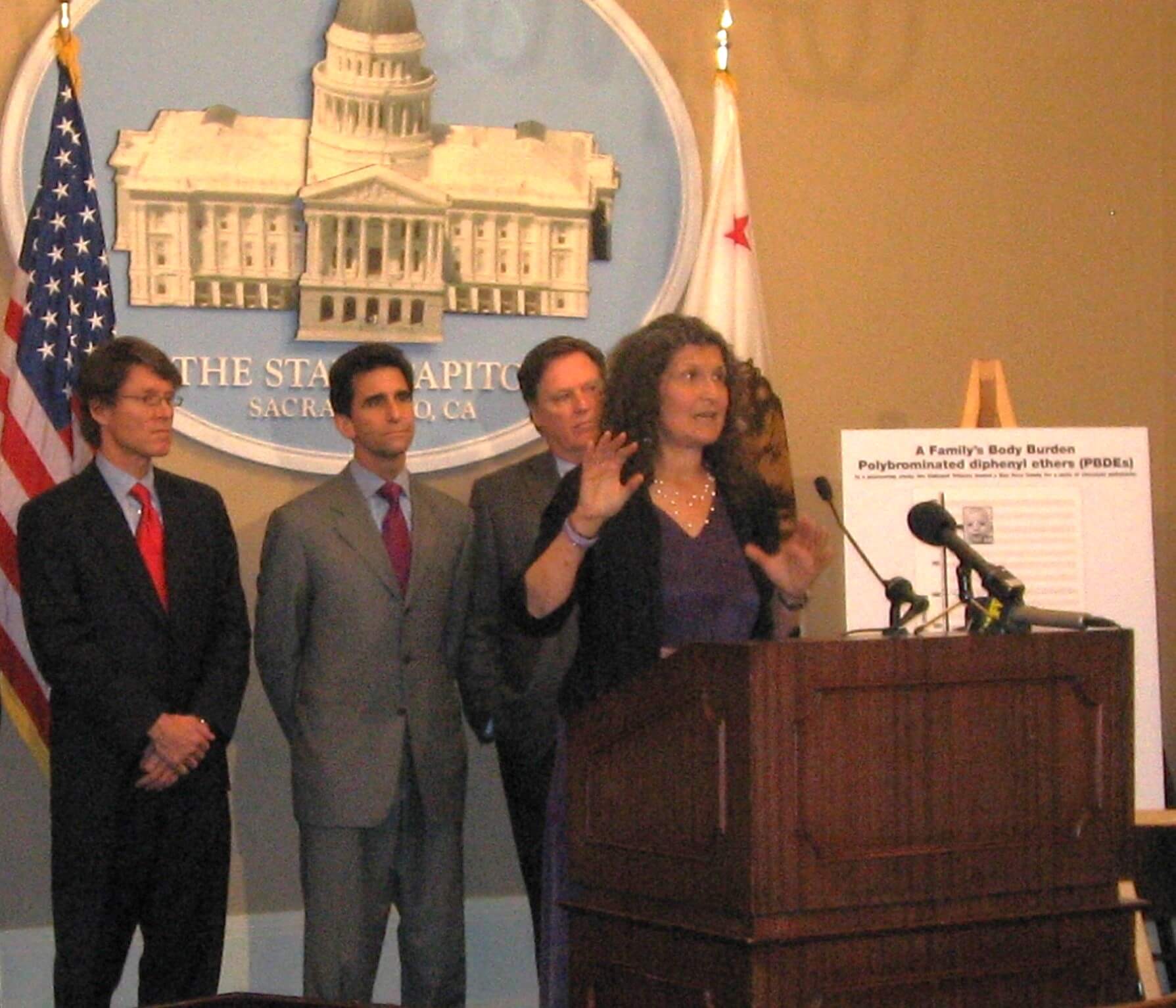September 2024: Scientists Spoke, Lawmakers Listened
In this edition:
- Are These Wipes on Your Kid’s Back-to-School List?
- When Scientists Raise an Alarm, Policymakers Listen
- Dirty Batteries for Clean Energy?
- Small PFAS, Big Concerns
- Green Science Policy Institute in the News
- Calendar
I hope you enjoyed a good summer and are ready for fall. We had a productive summer concluding with state, federal, and even global decision makers utilizing current science from our Institute and our colleagues to reduce chemical harm.
First, in a highly unusual move, the World Health Organization (WHO) scrapped its weak draft guidelines for PFAS in drinking water and reinitiated their scientific review. This was in response to criticism from scientists, including the letter we led from over 100 scientists. This is important, as WHO guidelines influence regulations around the world and, if lax, can be weaponized by those who have a financial interest. Read more in the blurb below.
After learning of our study finding harmful flame retardants in all 101 vehicles from 22 brands that we tested, Sen. Richard Blumenthal (D-CT) and Reps. Morgan Griffith (R-VA) and Doris Matsui (D-CA) sent a bipartisan letter to the National Highway Traffic Safety Administration (NHTSA) calling for an update of the agency’s 1971 vehicle flammability standard. The standard leads car manufacturers to add cancer-causing flame retardants to seat foam and other materials. This outdated regulation has no demonstrated fire-safety benefit. NHTSA confirmed to Autoweek that it is reviewing the congressional inquiry.
Also, Senators Gillibrand (D-NY) and Booker (D-NJ) wrote to the Food and Drug Administration (FDA) asking them to make a long-delayed decision on allowing the continued use of three unnecessary and potentially harmful antimicrobials—two quaternary ammonium compounds (QACs) and an organohalogen (chloroxylenol)—in over-the-counter hand and body washes. In 2016, the FDA issued a final rule banning 19 such antimicrobials.
However, they delayed their decision on these final three antimicrobials for one year… which has become eight years. Along with Earthjustice, we are circulating an organizational sign-on letter asking the FDA to hurry up and make their decision. Your organization can sign on to this letter with this form or by emailing [email protected] by this Monday September 16.
At the state level, California lawmakers have passed several important bills sponsored by our NGO colleagues to reduce our exposure to our Six Classes of harmful chemicals. Bills currently on Governor Newsom’s desk awaiting his signature include the Toxic-Free Medical Devices Act, which bans phthalates in IV bags and tubing; Product Safety: Bisphenol, which bans bisphenols in children’s feeding and teething products; and Household Product Safety: Toxic Substances: Testing and Enforcement, which provides enforcement of previously passed PFAS bans in food packaging, juvenile products, and textiles.
Also, the California School Food Safety Act, which bans some artificial colors in foods and beverages offered to students by schools, passed both statehouses and awaits signing. The Act follows a study by the California Office of Environmental Health Hazard Assessment finding links between these dyes and behavioral and attention difficulties in children.
In the coming months, I will be giving a number of seminars for universities, government agencies, and others sharing more about how science can impact policy to protect our health. I love doing these talks and meeting with scientists and students to help inspire them to do scientific research towards a healthier and more just world. These talks also provide our Institute with new connections and fruitful collaborations. Please see the calendar at the bottom of this message for more information or if you would like to attend one of these talks.
You can learn about my lectures and sign up for my quarterly personal newsletter at www.ArleneBlum.com. If you might like me to speak to your university or organization, please do get in touch.
Finally, we are continuing our search for a Principal Scientist to join our Institute. The new Principal Scientist will be my thought partner and help me manage our staff and operations. They will also collaborate with our team on our science and policy projects. We are looking for a senior scientist with a broad vision who wants to help create positive change based on science and has had significant management, policy, and NGO experience. To learn more and apply, see our Jobs Page. Please share with scientists who may be a good fit.
Best wishes for autumn,
Arlene and the Green Science Policy team
P.S. If you are a scientist or NGO who would like a Berkeley office in which to work, please get in touch. Our Institute has a free room in our lovely North Berkeley office.
Are These Wipes on Your Kid’s Back-to-School List?
By Rebecca Fuoco
We’ve been hearing from concerned parents that school supply lists are asking children to bring disinfecting wipes for their desks.
Many wipes contain QACs, which have been linked to reproductive, developmental, respiratory, dermal, and neurological harms and may contribute to the global health threat of antimicrobial resistance. The Center for Disease Control recommends using regular soap and water for cleaning as it removes most types of harmful germs including viruses, bacteria, parasites, and fungi.
There is no need for a disinfectant which may be harmful for us and especially to our children. For most everyday cleaning, plain soap and water is best.
This trend is disturbing, especially considering that asking kids to use these wipes in public K-12 school is against the law in California and likely other states.
Did your child’s school supply list include disinfecting wipes? If so, has your child been instructed to use the wipes on their desk or other school surfaces? If so, please get in touch with [email protected].
When Scientists Raise an Alarm, Policymakers Listen
By Anna Soehl
For decades the World Health Organization (WHO) has been providing drinking water quality guidelines. These are intended as a starting point for regulatory bodies around the world to develop their own criteria for chemicals of concern and healthy drinking water.
Given the importance of WHO guidelines, the weak nature and lack of transparency about the authorship of the 2022 WHO proposal for the two most well-studied PFAS (PFOA and PFOS) raised an alarm among the scientific community. In response, our Institute convened a small group of scientists, who summarized the numerous concerns in an open letter to WHO, urging a complete overhaul of the guidelines.
This letter was signed by over 100 PFAS environmental health scientists from around the globe. Other detailed comments were submit by the New Jersey Department of Environmental Protection. The letter was covered by the Guardian and other media. Also, two former U.S. federal government scientists, Betsy Southerland and Linda Birnbaum, expressed their concerns in an ES&T viewpoint.
In response, the WHO has scrapped these inappropriate guidelines and reinitiated their scientific review. The WHO formed a much more open Technical Advisory Group and will conduct a systematic review of evidence of health effects and exposure beyond just the two PFAS. We are encouraged by this WHO course-correction and confident that the PFAS experts will improve this important process.
Dirty Batteries for Clean Energy?
By Ariana Spentzos
Lithium-ion batteries underpin modern life, from earbuds to electric vehicles. As their use is growing, new safety standards are being implemented that aim to reduce fire risks—but they may also lead to the unnecessary use of harmful flame retardant chemicals. Flame retardants are known to pose serious health risks, including cancer, neurological harm, and reproductive issues.
Although most flammability standards do not specifically require flame retardants, they are usually the least expensive and easiest way to meet flammability tests, leading to their use in lithium-ion battery enclosures without proof of fire-safety benefit in real-world scenarios.
Flame retardants can migrate from products during use, contaminating homes, workplaces, and the broader environment. They can also impede sustainable recycling and increase smoke toxicity during a fire. Despite this, new legislation with flammability standards for batteries is leading to flame retardant use in plastic surrounding lithium-ion batteries.
We support the major parts of new flammability standards that will improve battery safety. However, fire-safety benefits should be demonstrated before mandating standards that de facto lead to the use of flame retardants. Fire prevention strategies for lithium-ion batteries, such as better battery manufacturing and improved battery management systems, should be prioritized. By focusing on real safety improvements rather than flame retardant use, we can protect both people and the planet while still advancing clean energy technologies.
Small PFAS, Big Concerns
By Lydia Jahl
One reason we advocate for treating PFAS as a class is that the more supposedly “safe” PFAS are studied, the more we learn about their health and environmental harms. Claims that short-chain PFAS are safe have been debunked, and now the safety of ultra-short-chain PFAS, especially trifluoroacetic acid (TFA), is being questioned. This molecule is used by various industries and is a breakdown product of many fluorinated refrigerant gases as well as pesticides and pharmaceuticals.

TFA has been detected at growing concentrations globally, and we wrote last year about TFA detected in United States dust, drinking water, and people. Our colleagues at the Ecology Center just reported on TFA in rainwater around Michigan. In most locations, they found that TFA levels were substantially higher than all other PFAS. This is particularly concerning because standard water filtration systems cannot remove TFA. A new article, The Global Threat From The Irreversible Accumulation Of Trifluoroacetic Acid (TFA) summarizes TFA harms, including that TFA may be a presumed human reproductive toxicant – particularly concerning given that TFA was just detected in the tens of thousands of ppt in fruit juices in Sweden.
Because TFA is persistent and can travel through the air and waterways, it is found even in remote areas. But another new study reported higher levels near electronic waste facilities. Electronics recycling has long been known as a source of flame retardants and other harmful chemicals, but we were surprised to learn that TFA made up nearly 50% of the total measured PFAS concentrations in the soil near an e-waste facility in Pakistan. As the researchers stated (and we agree!) more investigations are needed to safeguard public health, and in the meantime, the use of TFA and its precursors should be limited.
Green Science Policy Institute in the News

By Rebecca Fuoco
Below are recent news articles, blogs, podcasts, newsletters, and more that have featured our Institute’s work and expertise.
- The bipartisan and bicameral letter from Congress to NHTSA and our research that sparked it was covered by Autoweek, The Street, Repairer Driven News, Shifting Gears, and InsideEPA. “The bottom line is that the standard is 53 years old, and needs to be updated to one with proven fire safety benefit that can be achieved without the use of harmful chemicals,” our scientist Lydia Jahl told Autoweek.
- “It’s not just PFAS – [semiconductor manufacturing] is a very dirty business,” Arlene told Tom Perkins in The Guardian. “It seems like a really bad idea to exempt these plants from regulation.”
- Common Dreams noted that our scientists’ letter was part of the criticism that led to WHO to scrap its weak PFAS guidelines.
- Our scientist Lydia Jahl was a guest on Iowa Public Radio’s River to River in an episode about PFAS in food packaging.
- Sway shared our advice to avoid non-essential uses of PFAS, including in nonstick cookware.
Calendar
September 17, 2024 at 1:10pm Eastern:
NACWA PFAS Virtual Workshop
Arlene will present the opening keynote talk “A Decade of Reducing Harm from PFAS: Research, Policy, & Persistence” at the National Association of Clean Water Agencies PFAS Virtual Workshop. You can register here.
September 30, 2024 at 4pm Pacific:
UC Santa Cruz, Physical Sciences Building, Room 240.
Arlene will present "Reducing Chemical Harm: Organohalogens and the Class Concept” at the Chemistry Seminar at UC Santa Cruz. This talk is open to the public.
October 8, 2024 at 1pm Eastern:
University of North Carolina, McGavran-Greenberg, Room 1301
Arlene will give a talk to the UNC Dept. of Environmental Sciences and Engineering entitled “The Chemical Class Approach towards Healthier Products and People.” You can tune in on Zoom here.
October 10, 2024 at noon Eastern:
NIEHS, Research Triangle Park, NC.
Arlene will present "Reducing Chemical Harm: Organohalogens and the Class Concept” to the National Institute of Environmental Health Sciences staff.
October 11, 2024 at noon Eastern:
Duke University, Field Auditorium, Room 1112 Grainger Hall
Arlene will speak about “Reducing Chemical Harm: Organohalogens and the Class Concept” as part of the Duke University Program in Environmental Health/Superfund Center seminar series. This talk is open to the public.
Receive Updates By Email
Subscribe to our monthly newsletter and get these updates delivered right to your inbox!




